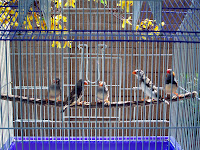 |
| Big Red in back, Ezra in front |
 | ||
| Ezra arranging materials in the nest cup |
 |
| Ezra shaping the nest cup by wiggling back and forth |
The Red-tailed hawk (RTH) is the most common species in North America, living in the continental US year-round, into Canada during breeding season, and down in Mexico during the winter. A very large Buteo hawk, second in size to the Ferruginous, the females weigh on average 2.5 pounds, with a body length of about 2 feet and a wingspan of approximately 4 feet; the males, as is typical in raptors, are smaller.
All raptors are hunters, earning the term "birds of prey". The preferred foods of RTHs are small mammals, but they also go after smaller birds, snakes, and sometimes carrion. They have extremely powerful feet for catching prey, and razor-sharp beaks for tearing their food. As dangerous as they are, they are extremely gentle, nurturing, and dedicated parents. They mate for life, or until a more dominant bird takes over.
Big Red will lay between 1 and 5 buff-and-speckled eggs, about the same size as a chicken egg, which they both will incubate for an average of 30 days. Raptors are altricial birds, which means the chicks will hatch completely helpless, with only the lightest of fuzzy down; for Big Red and Ezra, their chicks will 'live at home' for 4 to 6 weeks before fledging and finding their own territories.
Their courtship ritual is quite the sight: after soaring in high circles, the male will dive down, then back up, at steep angles; several aerial feats later, he swoops down to the female, extends his legs, and touches her briefly. On occasion, they will lock talons and spiral to the ground, letting go and regaining altitude sometimes at what seems the last minute.
You can keep up with Big Red at Ezra at the Livestream site:
Read more about Red-tailed hawks and other birds at the Cornell University's All About Birds site:
Stay tuned to this blog for other nestcam updates, and thank you for stopping by!
Bird Girl




















